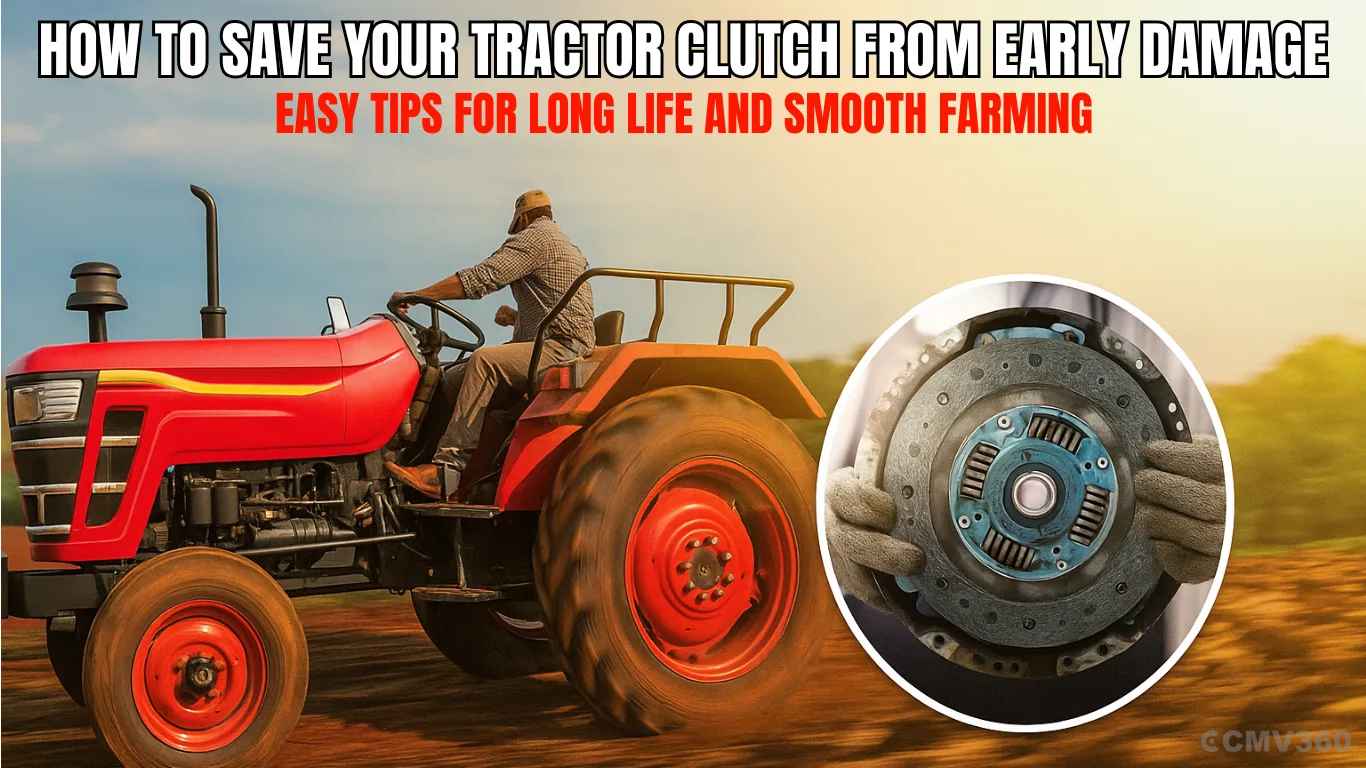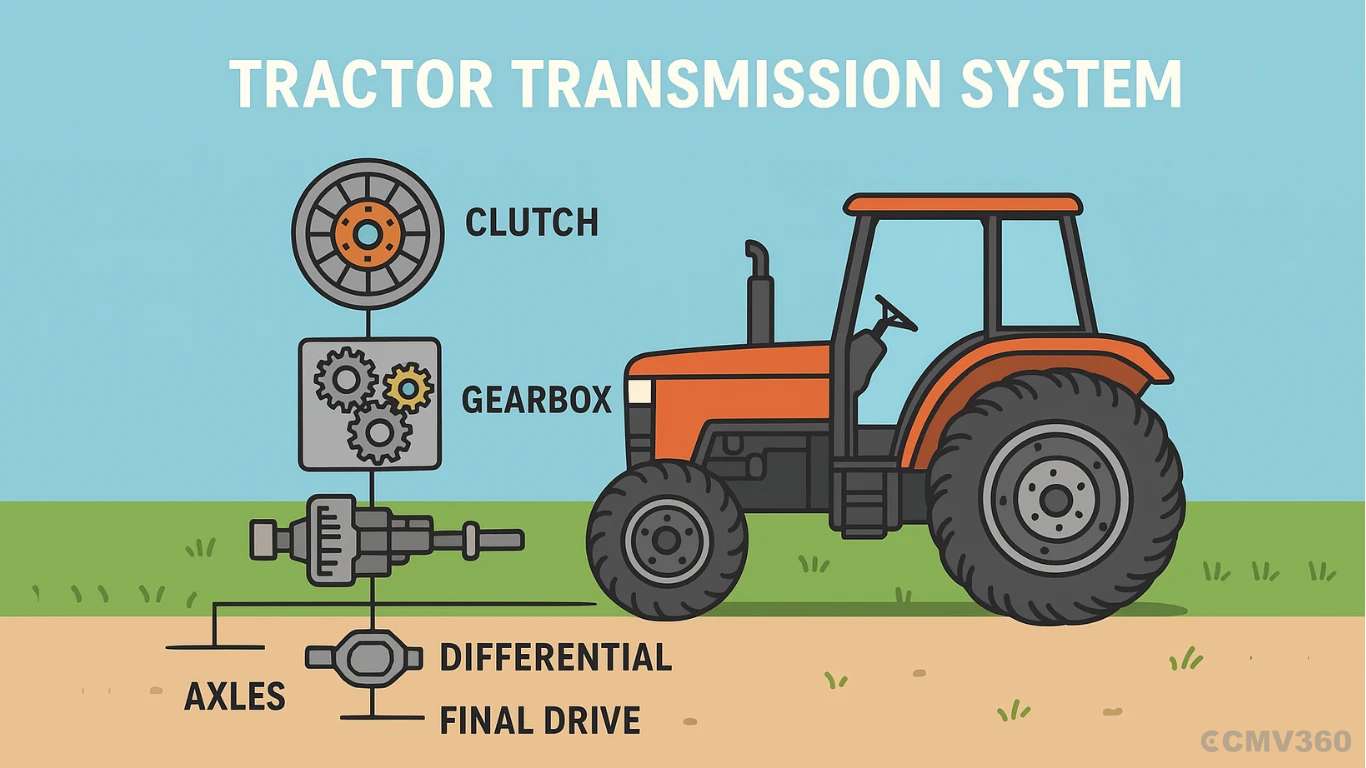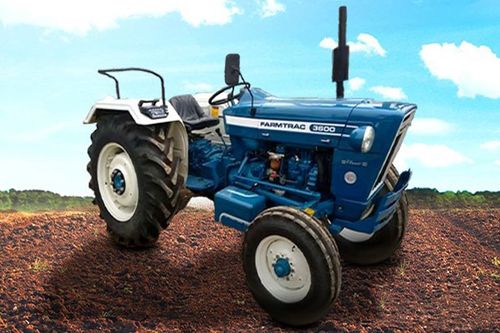Ad
Ad
How to Save Your Tractor Clutch from Early Damage: Easy Tips for Long Life and Smooth Farming

Tractors play a vital role in Indian agriculture, from ploughing and sowing to transporting crops. However, many farmers often overlook one of the most important parts of their tractor, the clutch. This component directly affects the tractor’s power, performance, and efficiency. A damaged clutch not only hampers your work but also leads to costly repairs. That’s why it’s essential to understand how to care for your tractor clutch and avoid early damage.
Also Read: Monsoon Tractor Maintenance Guide: Keep Your Tractor Safe and Productive in Rainy Season
In this article, you will learn about:
Common signs of clutch failure
Daily checks to prevent damage
Easy maintenance habits for long life
Practical tips for operating under heavy loads
What Is the Role of a Tractor Clutch?
The clutch connects and disconnects the tractor's engine from the transmission system, allowing you to change gears smoothly and control power to the wheels. It helps regulate engine power during different farming tasks. If the clutch fails, the tractor loses efficiency, becomes harder to drive, and may stop working altogether.
Common Symptoms of Clutch Failure in Tractors
Recognizing early signs of clutch problems can save you from expensive repairs. Look for these warning signals:
1. Power Loss: If your tractor feels weaker during heavy work or cannot handle its usual load, the clutch may be slipping. This happens when the clutch plates wear out and can’t grip properly.
2. Difficulty Shifting Gears: Trouble shifting gears, especially if there is a jerk or the gears stick, means the clutch plates are likely worn and may need replacement.
3. Tight or Loose Clutch Pedal: If the clutch pedal feels either too stiff or too loose, the clutch system may be out of balance. This often indicates issues with the clutch assembly.
4. Burning Smell: A burning smell, especially near the gearbox, is a clear sign that the clutch plates are overheating due to friction and may soon fail.
Also Read: Solis 4515 E vs Mahindra 575 DI XP Plus: Which Tractor Offers Better Value for Farmers?
Four Easy Methods to Keep Your Tractor Clutch in Good Condition

Following these practical and simple habits can significantly extend the life of your clutch.
1. Avoid Half-Clutch Driving: One of the biggest mistakes is pressing the clutch halfway while driving. This causes continuous friction between the clutch plate and flywheel, leading to faster wear and tear. Always fully press the clutch when changing gears and release it completely after.
2. Don’t Overload the Tractor: Overloading forces the clutch to handle more stress, which leads to early slipping and damage. During heavy tasks, use low gears and avoid frequent gear changes. This helps reduce pressure on both the clutch and transmission.
3. Check Clutch Free Play Regularly: Free play is the distance the clutch pedal can move before resistance is felt. Ideally, it should be around 1 to 1.5 inches. Check it every 15–20 days. If it’s not within this range, get it adjusted immediately to avoid long-term damage.
4. Lock the Clutch During Long Inactivity: During the off-season or monsoon, when the tractor is unused for long periods, the clutch plates can get stuck. Always press the clutch pedal and lock it if the tractor will be stationary for weeks or months. Many modern tractors come with a built-in clutch lock feature.
Practical Tips for Daily Use to Avoid Clutch Damage
1. Do Not Ride the Clutch: Resting your foot on the clutch while driving causes unnecessary friction. Remove your foot completely from the clutch pedal when not shifting gears.
2. Smooth Gear Shifts: Always press the clutch fully when changing gears and release it gradually. Avoid sudden gear changes or high-speed starts, especially under load.
3. Avoid High RPM Starts: Starting the tractor with too much acceleration causes the clutch to overheat. Use a moderate engine speed for smoother engagement and longer clutch life.
4. Shift to Neutral When Stopped: If the tractor is stopped at a signal or during fieldwork, do not keep the clutch pressed. Shift to neutral to avoid extra pressure on the clutch.
Also Read: Is Your Tractor Giving Low Mileage? Follow These 10 Easy Tips to Save Fuel and Increase Profit
Special Precautions for Heavy Load Operations
Operating tractors under heavy loads requires special care to protect the clutch:
Use Low Gears on Slopes: When moving uphill or with heavy equipment, use lower gears for better power transfer and less clutch stress.
Use Handbrake on Inclines: On slopes, use the handbrake to hold the tractor. Find the clutch's bite point and then release the handbrake to prevent rollback and clutch slipping.
Avoid Frequent Stops: Continuous start-stop actions increase clutch usage. Plan work to reduce frequent halts.
Avoid pressing the Brake and Clutch Together: Use both pedals together only when necessary to avoid unwanted clutch engagement.
Simple Daily Checks to Extend Clutch Life
1. Check Clutch Pedal Free Play: Look for correct pedal movement before resistance. Follow your tractor’s manual for exact settings.
2. Smooth Pedal Operation: The clutch pedal should move smoothly and return easily. Any stiffness, noise, or sticking means a problem.
3. Look for Leaks: Oil or hydraulic fluid leaks near the clutch area can cause slipping and need immediate attention.
4. Listen for Unusual Noises: Any strange sounds when using the clutch may indicate internal damage. Get it checked by a mechanic.
5. Inspect for Visible Damage: Look for cracked, bent, or worn clutch cables or linkages. Replace damaged parts early.
6. Keep the Clutch Area Clean: Mud, dirt, and oil can block movement. Clean the area around the clutch regularly.
7. Follow Lubrication Schedules: Lubricate moving parts like clutch linkage and pivot points as per the manual.
Professional Maintenance and Clutch Adjustment
Schedule Regular Checkups: Get the clutch system checked by a professional every 50 hours of use or as recommended by your tractor manufacturer.
Replace Worn Components Early: Timely replacement of worn parts avoids bigger damage and ensures smoother operation.
Follow Manufacturer’s Guidelines: Each tractor model is different. Always follow your user manual for correct settings, maintenance routines, and clutch care.
CMV360 Says
Maintaining your tractor’s clutch is easy and requires just a few simple habits like avoiding half clutching, not overloading the tractor, regularly checking free play, and locking the clutch during long breaks. These small efforts, along with timely maintenance, can significantly reduce repair costs and prevent downtime during farming. By following these tips, you not only extend the life of your tractor clutch but also ensure smooth and efficient operation for years. Share these helpful practices with fellow farmers to promote better tractor care and boost productivity across the farming community.
Features & Articles
5 Deadly Wheat Diseases That Can Destroy Your Crop – Learn Their Symptoms & Best Protection Methods
Learn about five dangerous wheat diseases, their symptoms, and effective protection methods. Simple, clear, and helpful guide for farmers to prevent crop loss and increas...
12-Dec-25 05:14 AM
Read Full NewsPradhan Mantri Krishi Sinchayee Yojana (PMKSY) – Per Drop More Crop
“Learn about the Pradhan Mantri Krishi Sinchayee Yojana – Per Drop More Crop, focusing on micro irrigation, water efficiency, farmer benefits, subsidy details, eligibilit...
29-Nov-25 11:07 AM
Read Full Newse-NAM: India’s Digital Revolution for “One Nation, One Market” – Complete Guide, Benefits, Eligibility & Registration
Learn everything about e-NAM, India’s digital agriculture market. Know its benefits, objectives, eligibility, documents, and simple online registration steps for farmers,...
28-Nov-25 11:44 AM
Read Full NewsMastering Tractor Power: Complete Guide to Transmission System, Parts, Types & Functions for Smarter Farming
Learn about the tractor transmission system, its parts, types, and functions. Understand how clutches, gearboxes, and axles work together for better tractor performance....
03-Nov-25 12:33 PM
Read Full NewsInternational Day of Awareness of Food Loss and Waste 2025: Promoting Sustainable Food
Explore the importance of the International Day of Awareness of Food Loss and Waste 2025, its theme, impact, and solutions for building sustainable, efficient, and equita...
25-Sep-25 10:01 AM
Read Full NewsMore Work with Less Diesel: 7 Easy Tips to Increase Tractor Mileage and Save Farming Costs
Follow 7 simple tips to improve tractor mileage, save diesel, and lower farming costs. Learn about the top mileage tractors in India for 2025 and make farming more profit...
17-Sep-25 07:25 AM
Read Full NewsAd
Ad
As featured on:


Registered Office Address
Delente Technologies Pvt. Ltd.
M3M Cosmopolitan, 12th Cosmopolitan,
Golf Course Ext Rd, Sector 66, Gurugram, Haryana
pincode - 122002




















